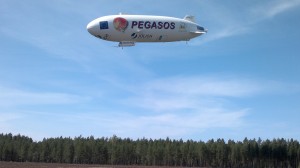 Since the beginning of May 2013, a zeppelin has been flying over southern Finland. The zeppelin was brought to Finland as part of a European project PEGASOS to measure aerosol particles and trace gases in the lowest layers of atmosphere up to about 1.5 km.
Since the beginning of May 2013, a zeppelin has been flying over southern Finland. The zeppelin was brought to Finland as part of a European project PEGASOS to measure aerosol particles and trace gases in the lowest layers of atmosphere up to about 1.5 km.
As part of PEGASOS (Pan-European Gas-AeroSOls-climate interactions Study), an international group of scientists studies the effect of human emissions to climate change. Last summer research flights with the zeppelin were carried out in polluted areas in Central and Southern Europe. This time, we measure in Finland where the air is cleaner, anthropogenic emissions smaller, and biogenic effects more important.
In Finland 30 scientists, 10 technicians and 2 pilots operate the zeppelin and the instruments it is carrying. While in Finland, the zeppelin is stationed at Jämijärvi airport and the flights are mostly directed between Jämijärvi and Hyytiälä or around Jämijärvi.
The “flying laboratory” build in the zeppelin is equipped with state-of-art scientific instruments specially designed to investigate aerosol particles and trace gases. The instruments are divided into three cabin layouts and only one can fly at a time. Each of the layouts has a specific scientific focus point: new particle formation, photochemistry, and secondary organic aerosol – together covering a wide range of atmospheric physics and chemistry.
The zeppelin complements the extensive ground-based measurements and airplane measurements carried out in the planetary boundary layer. This airship offers a unique combination of capabilities which is not available when employing other aircrafts. The airship can stay at nearly fixed position, making it possible to follow time development of various events, such as industrial emissions or particles from natural sources. On the other hand, the airship can change height quickly and operate also at low altitudes which allows for measurement of the vertical profiles of trace compounds with high time resolution, also at the lowest hundreds meter above ground.
The research flights will continue until mid-June 2013. So far, the measurements have given new information about atmospheric mixing and layering as well as transportation of particles and gases in the atmosphere and detailed information on spatial variation of fine particles and gases from natural and human made sources.
Hanna Manninen & Taina Yli-Juuti
Blog for the EU PEGASOS Project:
http://eu-pegasos.blogspot.fi/
PEGASOS Project home page:
http://pegasos.iceht.forth.gr/
